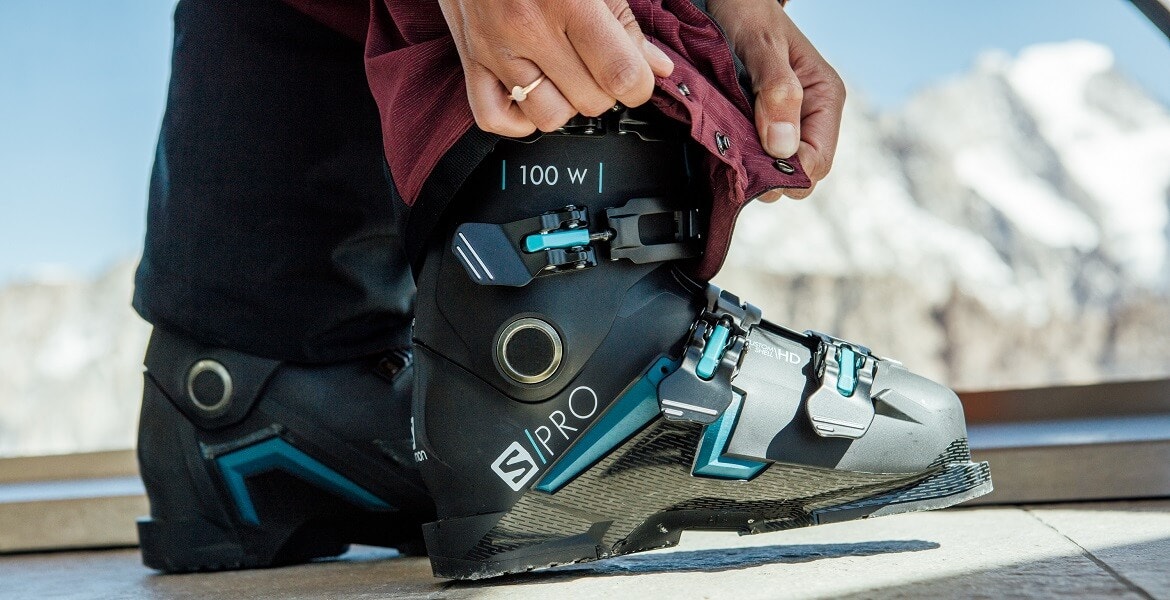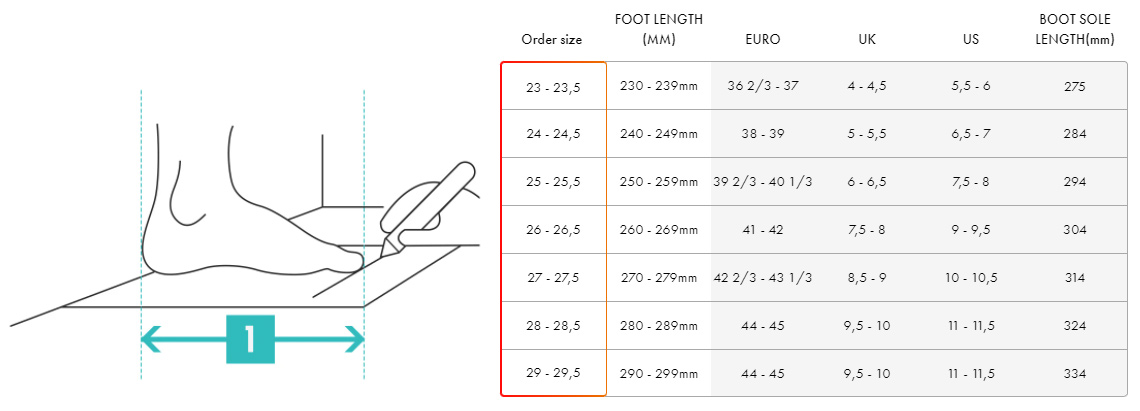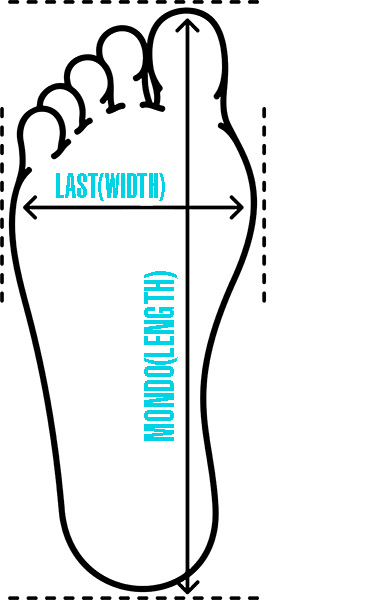Our guide to choosing and fitting the right ski boots for you
There are quite a few things to consider when choosing a ski boot, firstly the size and width. Ski boots are sized in Mondo size and the width of the boot, which is called the last. We will cover these 2 first.

How do you find your Mondopoint Size for Ski Boots?
Your mondo size is essentially the length of your foot in centimeters. The simplest way to find this is to stand on a piece of A4 paper with your heel pressed against the wall or skirting board, making sure the paper is touching in the same place. Then put a mark at the end of your big toe, the longest part of your foot. Measure the length from that mark to the heel edge of the paper and that length in cm is your mondo size.
If you have a pair of ski boots that fit you already, the chances are that the mondo size of the boot is printed on the toe, heel or sole of the boot. If you can’t find it on the boot then you can also find it by measuring the boot. If you remove the insole from the boot you can insert a steel tape measure in to the boot and measure from the toe to the heel. That length, to the nearest half centimeter, or 5mm, is the Mondo size of the boot.
Most ski boots are sold to fit 2 mondo sizes, this is because the shell of the boot can accommodate that size range. The boot inner, often combined with an additional insole, will make up that difference.
The most important thing to remember is if you are in between 2 boot sizes ALWAYS go for the smaller size.
What is ski boot last and how do I measure it?
The last of a ski boot is the width. You need to measure the width of your foot in a similar way to which you measured your length. Put a piece of paper up against a wall, but parallel with it this time. Put the inside of your foot up against the wall and mark with a pencil the widest part of your foot around the ball of it. This width in mm is known as the last.

Now you know the width of your foot you can choose you ski boot, but you also need to consider the level of precision you need when skiing:
 | You can use this table as a guide
Its important that the boots are comfortable, but also remember that they will give when worn. Ski boots that are too wide won't support your foot and controlling your skis will be more difficult. |
Armed with your size you can now look at choosing a pair of boots. Depending on the level of skier you are will depend on the type of boot you are looking for and how much Flex you need.
What is Ski boot Flex and why is it important?
Flex is another term for rigidity, the softer the flex the more forgiving it is, the harder the flex the more precise the boot will be in transferring your actions to the ski. Beginners would choose a softer boot with a flex beginning at 60. Professionals might be looking at boots with a flex of around 140.
There is no universal system for measuring flex and it may vary slightly from brand to brand, but the philosophy is the same, the lower the number the softer the boot.
This table gives you some basic info on choosing the right flex for your ability with Salomon Ski Boots
Womens Ski Boots
- Flex from 60 to 90: beginner or occasional skier, recreational skier
- Flex from 90 to 110: skis regularly and has a good ability level
- Flex from 110 to 120: expert skier with a very high ability level
- 130 and over: competitive skier
- Flex from 70 to 90: beginner or occasional skier
- Flex from 90 to 120: skis regularly and has a good ability level
- Flex from 120 to 130: expert skier focused on performance. Or big guys.
- 140 and over: competitive skier
Fitting your boots at home.
Now you have chosen and received your ski boots you need to make sure they fit. Make sure you are wearing the same socks you will be wearing when you are skiing. Open all the buckles on the boot and make sure they aren’t caught in the teeth but turning them around 90 degrees. Pull the tongue forwards to open the boot up and put your foot in. Now proceed to do the boot up starting at the toe end and ending at the knee end. Do the buckles up to the half way point. You may need to repeat the tightening process by starting again at the toe buckle and working your way up again to get the correct fit. If you can do the buckles up to over half way easily then the boots aren’t going to be right for you as they have too much volume. You will end up maxing out the buckles and not having enough tension over your foot, so you need a different pair.
Once you have them done up, stand up in the boot, your toes should be touching the end of the boot and they should feel too small. Your heel should not be able to lift, you should be able to wiggle your toes but not scrunch them. Remember though that being stood up and walking around in them is not how you ski and not how you should decide the fit of them. First off bang the back of the boot on the floor to make sure your heel is as far back as possible, not bend you knees and take a skiing stance, this has the effect of pulling your toes back from the end of the boot. Now you are in a skiing position and can assess the fit of the boots effectively. Do a few jumps in the boots and check the tightness of the boot again. It will loosen up as your foot settles in to it, so you will need to revisit the buckles working you way up them a notch at a time until you have them as tight as you can get them and still be snug and comfortable. If they are causing any pain or pins and needles, then loosen that part of a bit. You may need to revisit this a few times until you have the perfect settings for you. If they are still causing problems then these are probably not the boots for you and you will need to look at choosing a pair with different length, flex or last.
Speak to us and we can advise based on the any issues you have

